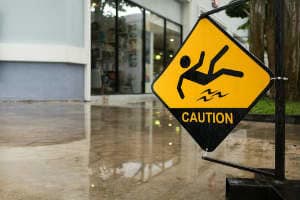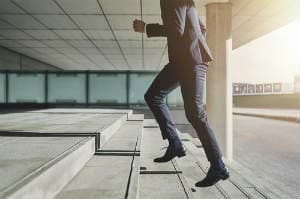Most accidents that occur in the workplace and lead to worker injuries are slip, trip and fall accidents.
In fact, the Occupational Safety and Health Administration (OSHA) says slip-and-fall accidents cause 15 percent of all accidental deaths, about 25 percent of all workplace injuries and more than 17 percent of all disabling injuries on-the-job.
Work-related injuries and deaths are caused by employees slipping, tripping or falling from work surfaces such as floors, platforms, roofs, scaffolds, ladders, stairs and ramps.
Employers in Kentucky have a legal duty to ensure their workplaces are free of hazards that could cause their employees to be injured or killed. Employers are required to train workers in safety protocols and to provide safety equipment for workers whose jobs entail fall risks.
In addition, employers have a financial incentive to reduce slip-and-fall accidents. Worker injuries cost employers in multiple ways: lost productivity, increased workers’ compensation, higher insurance premiums, and the expense of hiring and training replacement workers.
According to OSHA, most slip-and-fall accidents that occur in the workplace are avoidable.
Adapted from OSHA and the National Institute for Occupational Safety and Health (NIOSH) guidelines and training modules, here are five areas in which employers can reduce slip-and-fall accidents and improve worker safety.
1. Design Workplaces to Eliminate Slipping, Tripping, and Fall Hazards
 Provide adequate lighting to keep work areas, aisles and paths that workers travel well lit.
Provide adequate lighting to keep work areas, aisles and paths that workers travel well lit.- Ensure that stairwells have sufficient lighting and that stairs have hand rails.
- Install slip-resistant flooring on stair treads, ramps and other high-risk areas.
- Ensure that edges of steps and other changes in elevations are brightly marked/highlighted.
- Use non-slip mats in areas where employees may encounter wet flooring, such as at entrances, particularly in winter months.
- Secure entrance way mats to floors and ensure they are large enough for several footsteps to fall on the mat before shoes contact bare flooring.
- Ensure that worksite floor and wall openings have railings, markings, toeboards, and covers, as required by OSHA regulations.
2. Engineer Work Processes to Reduce Exposure to Slip-and-Fall Risks
- Prevent certain machinery and work processes that discharge liquids, oils, particles, dusts or offal from creating slipping hazards on workplace floors with:
- Enclosures that sequester certain machinery or operations
- Work surfaces with raised or lipped edges to contain spills
- Exhaust ventilation that removes dust, particulates, steam, condensation.
- When wet processes are part of the job, provide workers with platforms, non-slip mats, or other dry places to stand.
- Ensure that cords, computer cables, hoses, and tubing do not cross walkways creating trip hazards, and are not bunched or tangled under desks or work stations.
3. Maintain Housekeeping, Maintenance, and Groundskeeping to Prevent Fall Hazards
 Establish housekeeping and groundskeeping schedules, policies and staffing levels that ensure worksites are routinely inspected in a timely manner.
Establish housekeeping and groundskeeping schedules, policies and staffing levels that ensure worksites are routinely inspected in a timely manner.- Keep work areas clean and dry.
- Keep walkways, corridors, and passageways clear of obstructions.
- Ensure that ladders are maintained and inspected prior to each use, and are installed safely.
- Ensure that ladders are not be placed in front of doors opening toward the ladder unless the door is locked, or guarded.
- Provide and require that workers use fall protection equipment if they work on roofs, ladders or other elevated surfaces.
- Keep gravel, stone, mulch and other bedding materials out of walkways. Avoid using gravel or stone in landscaping.
- Replace broken or loose paving stones, bricks, tiles, and other flooring or landscaping material intended to bear pedestrian traffic.
- Patch, fill, or repave outdoor areas that have deep grooves or holes, or cracks exceeding ½-inch wide.
- Place brightly colored barricades around deep holes or ditches to prevent falls.
- Ensure that underground irrigation system structures are covered or highlighted.
4. Prepare for Seasonal Weather — Kentucky Snow, Ice, and Outdoor Surface Hazards
- Maintain staffing and scheduling to ensure prompt mitigation of ice and snow hazards in parking lots, garages and walkways, and at building entrances.
- Use snow removal methods that do not involve workers going on roofs. Use ladders to apply de-icing materials, and/or use snow rakes or drag lines from the ground.
- Provide additional mats in entrances during winter months and when it rains.
- Place labeled bins filled with ice melting chemicals and scoops in areas of heavy pedestrian traffic that any employee can use on icy patches.
- Distribute winter weather warnings to staff via text, email or other means when ice and snow are predicted.
5. Train Employees to Avoid Unsafe Behaviors That Increase Slip, Trip, and Fall Injuries
Employees should avoid:
 Being in a hurry and rushing.
Being in a hurry and rushing.- Engaging in horseplay.
- Taking unapproved shortcuts through high-risk or restricted areas.
- Failing to wear proper footwear with good traction.
- Carrying or moving cumbersome objects, or too many objects at one time.
- Using chairs, boxes, drawers, shelves or other furniture or objects instead of a portable ladder or step tool.
- Leaving tools and equipment lying in walkways, on lawns, decks or patios, in garages or otherwise not properly stored after use.
Our Kentucky Slip-and-Fall Accident Lawyers Investigate Workplace Injuries and Premises Liability Claims
Slip and-fall accidents can be prevented. If you’ve been injured in a workplace fall in Kentucky, call an experienced personal injury attorney from the Becker Law Office.
If you are an employee who was injured while on the job, you deserve workers’ compensation for your medical expenses and a portion of your lost wages. If you were injured in a slip-and-fall accident while visiting a business, you may be able to obtain compensation for medical expenses, lost wages, pain and suffering and more through a personal injury lawsuit. Call us for a free review of your accident and legal options.
Tag: 5 Guidelines for Preventing Workplace Slip-and-Fall Accidents
 Provide adequate lighting to keep work areas, aisles and paths that workers travel well lit.
Provide adequate lighting to keep work areas, aisles and paths that workers travel well lit. Establish housekeeping and groundskeeping schedules, policies and staffing levels that ensure worksites are routinely inspected in a timely manner.
Establish housekeeping and groundskeeping schedules, policies and staffing levels that ensure worksites are routinely inspected in a timely manner. Being in a hurry and rushing.
Being in a hurry and rushing.